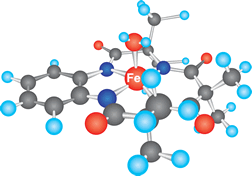This page has been archived and is being provided for reference purposes only. The page is no longer being updated, and therefore, links on the page may be invalid.
|
"Green" Catalyst Takes on Hormones in Wastewater
By Jan SuszkiwJune 29, 2006
Hydrogen peroxide is best known for its bubbly cleansing of minor cuts and scrapes. But combining it with an enzyme-like catalyst called Fe-TAML also produces reactions that break down dyes, pesticides and other wayward chemicals that have become environmental pollutants.
Now, the dynamic duo's powers of degradation may include neutralizing hormones in municipal and agricultural wastewater, an Agricultural Research Service (ARS) scientist reports today.
Speaking at an American Chemical Society meeting in Washington, D.C., ARS animal physiologist Nancy Shappell discussed the results of a laboratory study in which she combined Fe-TAML with hydrogen peroxide to break down estradiol, a natural form of the female hormone estrogen, and ethinylestradiol, a synthetic version used in contraceptives. Fe-TAML is short for iron tetra-amido macrocyclic ligand.
Shappell's collaborators are Terry Collins and Colin Horwitz with Carnegie Mellon University's Institute for Green Oxidation Chemistry in Pittsburgh, Pa., where Fe-TAML was developed; and Patrick Hunt and Kyoung Ro with the ARS Coastal Plains Soil, Water and Plant Research Center, Florence, S.C.
According to Shappell, with the ARS Red River Valley Agricultural Research Center in Fargo, N.D., the study dovetails with growing concern that hormones—whether flushed into sewage or excreted by livestock—can disrupt the endocrine systems of fish, other wildlife and potentially humans. While wastewater treatment plants remove most pollutants, contamination of surface and groundwater can still occur, notes Shappell, who is in the Fargo center's Animal Metabolism-Agricultural Chemicals Research Unit.
Ethinylestradiol is particularly worrisome because it is more resistant than estradiol to degradation by microbes and other natural processes. But in Shappell's lab experiments, hydrogen-peroxide reactions spurred by Fe-TAML made short work of the hormone. Indeed, more than 95 percent of it degraded within five minutes' exposure to the reaction. Estradiol met a similar fate, adds Shappell, who used high-performance liquid chromatography and tandem mass-spectrometry analysis to confirm the results.
In the next step, she'll team with the Florence lab to test Fe-TAML on hormones in effluent from hog-farm lagoons.
ARS is the U.S. Department of Agriculture's chief scientific research agency.

